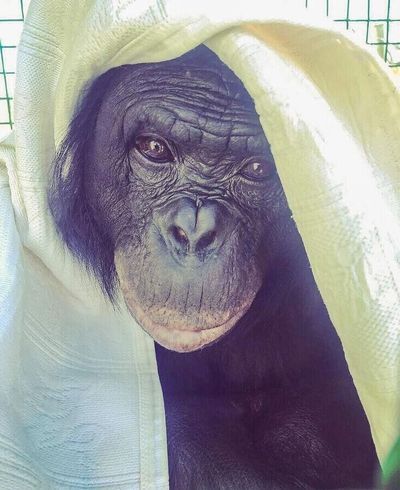Kanzi, bonobo ape and Peter Gabriel collaborator, turns 40

I first learned about Kanzi, who recently celebrated his 40th birthday, from one of his best-known musical collaborators.
The year was 2001, and Peter Gabriel, who was doing advance press for his album “Up,” took a break from our interview to show me “home videos” of himself playing music with the bonobo ape and his little sister, Panbanisha.
On screen, Gabriel is playing a sequence of slow synthesizer chords, not unlike something that might appear in one of his soundtracks. Panbanisha listens and begins to pick out delicate single notes on the keyboard, like a beginning and extremely hairy Brian Eno or Erik Satie.
“I asked her to only play on the white notes because I was playing in A minor,” said the former Genesis frontman, who communicated with the apes through an interpreter.
“She likes this note,” he added as the ape begins repeating a single note and its corresponding octave. “No one has ever told her about octaves. She finds out for herself. So, she’s either recognizing the pattern, or it’s through what she’s hearing.”
In the next clip, Panbanisha’s older brother has taken her place at the keyboard.
“Kanzi’s already had a book written about him, and he was getting sick that his sister here was getting all the attention,” Gabriel said. “So, he sat down at the keyboard and said, you know, basically, ‘I’m gonna be great.’ ”
While Kanzi approaches the instrument with less finesse, the results are still amazing.
“I mean that was the first time he sat down at a keyboard,” Gabriel said. “If you took any of us and put us down at a keyboard for the first time …”
Gabriel’s voice trails off as his attention returns to the screen, where Kanzi – backed by Gabriel and his tour mates Tony Levin and Richard Evans – has settled into a solid groove.
“OK, maybe the notes were random, but not the rhythm,” he said. “He’s hitting the triplets really well.”
Kanzi was born in 1980, the same year that Gabriel released his anti-apartheid protest song “Biko.”
Four decades later, he’s become the most famous bonobo in simian history with a résumé that includes playing piano with Paul McCartney, appearing on “The Oprah Winfrey Show” and hanging out with Anderson Cooper.
Today, Kanzi and six other bonobos reside at the Ape Initiative, a nonprofit Des Moines research facility dedicated to the study and conservation of his species. To celebrate his 40th birthday, the Ape Initiative’s staff presented Kanzi with a birthday cake of frozen fruit stacked in layers.
Kanzi has also become adept at using a keyboard with lexicons to communicate when there are no translators around.
According to a 2006 interview with psychologist and primatologist Susan Savage-Rumbaugh, who trained the two siblings, the device was once brought along on an outing to the Georgia woods where, after touching the symbols for “marshmallows” and “fire,” Kanzi was appropriately rewarded.
“Given matches and marshmallows,” she said, “Kanzi snapped twigs for a fire, lit them with the matches and toasted the marshmallows on a stick.”
Gabriel, meanwhile, continues to play a leading role in efforts to learn from this most human-like of non-human species.
In 2020, he and two internet pioneers put up $1 million to support interspecies language research. They also hosted a video conference in July where topics included the language of bonobos and the music of elephants.
The fact that Gabriel is still supporting these efforts comes as no surprise.
“If you can’t communicate with other cultures, you think, ‘How are we gonna make this work?’ ” he said as our conversation shifted back to more conventional topics. “But very often, once you start making noises, you find that there’s a language – some sort of emotional language – that you can use to connect.”